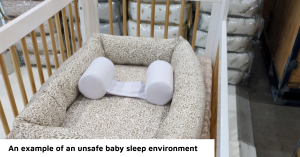World-first infant sleep testing standards released in Australia
New sleep testing standards mark a global wake-up call for safer baby products.
We’re not condemning brands that haven’t tested,” “Until now, they simply couldn’t. Now that tools exist, ethical brands will act. Why wouldn’t they? Unless they’re worried their product won’t pass?”
LONDON, LONDON, UNITED KINGDOM, June 26, 2025 /EINPresswire.com/ -- Today, Australia has released the world’s first dedicated infant sleep surface testing standards - offering a breakthrough in how baby products can be scientifically assessed for safety and sparking a global conversation around product transparency, trust, and safer sleep.— Cara Sayer, UK Safety Ambassador for INPAA and Inventor of SnoozeShade
These new standards are not yet mandatory, but they provide - for the first time - a validated, consistent methodology for testing the firmness of baby sleep products - including mattresses, loungers, and sleep positioners. Developed by Standards Australia with support from organisations including INPAA, Red Nose, River’s Gift, and others, the new standard sets a strong precedent for future regulation and international adoption.
“This isn’t about scaring parents - it’s about giving them more clarity and confidence,” said Cara Sayer, UK Safety Ambassador for INPAA and Inventor of SnoozeShade. “If a manufacturer truly believes their baby sleep product is safe, they should be eager to test it. These new standards are an opportunity - not a threat - and responsible brands should be embracing them voluntarily.”
What has changed?
The newly released AS5407.1 and AS5407.2 standards introduce a reliable, repeatable method for testing sleep surface firmness — an essential factor in reducing the risk of Sudden Unexpected Death in Infancy (SUDI) and Sudden Infant Death Syndrome (SIDS). Firm sleep surfaces help protect babies by keeping airways open and preventing dangerous sinking or suffocation.
Until now, there has been no consistent testing approach for many products marketed for baby sleep - especially soft loungers and positioners. These new methods fill that gap, providing both labs and manufacturers with a way to back up safety claims with real data.
For parents: clarity without fear
These new standards aren’t here to alarm families - they’re here to empower them. Parents can now ask a new question when choosing products:
“Has this product been tested using the new firmness standard?”
If the answer is no (or unclear) it’s reasonable to ask why not.
“Parents don’t need panic,” said Sayer. “They need proof. These standards allow families to feel more confident in what they’re buying - and start holding brands to higher standards of safety and transparency.”
For manufacturers: an opportunity — and a test of intent
These voluntary standards offer a clear opportunity for brands to prove their products are safe. While not legally required, integrating these tests into product development cycles is the obvious next step for responsible manufacturers.
“We’re not condemning brands that haven’t tested,” Sayer said. “Until now, they simply couldn’t. But now that tools exist, we expect ethical brands to act. Why wouldn’t they? Unless they’re worried their product won’t pass?”
Voluntarily adopting the standard shows a brand is committed to infant safety and is transparent about product development. It also helps earn long-term consumer trust.
“Safe brands will keep making safe products,” she continued. “What this really does is shine a light on those who’ve avoided scrutiny.”
Tim Wain: "This separates marketing from real safety"
“These new standards are a game-changer for infant safety - there’s no reason for brands to wait,” said Tim Wain, CEO of the Infant and Nursery Products Alliance of Australia (INPAA).
“Many Australian suppliers have already redesigned their products and adopting the standards voluntarily. But there’s still an influx of cheap, untested baby sleep products being sold online — especially positioners - that needs to stop.
To parents: be cautious of the word ‘breathable’ on packaging. It sounds reassuring, but without testing, it can hide real danger. That’s why the upcoming CO₂ standards are crucial - they’ll finally separate marketing claims from proven safety.”
Julie Milne: “we look forward to learning more about this important development”
“The Baby Products Industry Association welcomes any research into safer sleep for infants and any potential product improvements supporting this” said Julie Milne, Chair of BPIA Technical Committee.
Australia leads, but the conversation is global
Australia first introduced a mattress firmness standard in 2013. This updated methodology marks the next phase of global leadership in infant product safety.
“Other countries should watch closely,” said Sayer. “This is how change begins: with a voluntary standard, momentum, and eventually regulation. We owe it to parents - and to babies - to support progress wherever it starts.”
Cara Sayer
Really Simple Ideas Ltd
+44 7591474846
hello@snoozeshade.com
Legal Disclaimer:
EIN Presswire provides this news content "as is" without warranty of any kind. We do not accept any responsibility or liability for the accuracy, content, images, videos, licenses, completeness, legality, or reliability of the information contained in this article. If you have any complaints or copyright issues related to this article, kindly contact the author above.

